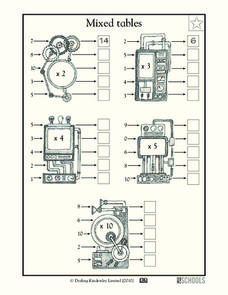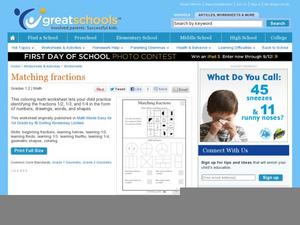Curated OER
More Than or Less Than?
How many apples is less than five? Each of these problems has two images, one with quantifiable details and one without (i.e. a tree with apples and an empty tree). Answers will vary as young counters draw objects onto the second image...
Curated OER
Teddies
Here's a really cute lesson that utilizes all of your children's teddy bears. Each pupil brings their favorite teddy bear to school. The lesson has many wonderful suggestions for learning activities that can be done with the bears once...
DK Publishing
Monster Math - Mixed Tables
How many buttons would there be on six monsters? Multiplication beginners examine a strange-looking creature as they write eight number sentences. For each, they are determining how many of a particular feature would be on a specific...
Curated OER
Patterns of 2s, 5s, and 10s
In order to connect the dots in three images youngsters skip count by twos, fives, and 10s. Encourage them to look for patterns as work, and consider giving out hundreds charts for guidance. They can also color these in once finished!
Curated OER
Bar Graphs
Introduce scholars to bar graphs and data analysis through analyzing these visual examples. First, they look at a pictograph of fruit types and answer five observation questions. There is one done for them as an example. Learners do the...
Curated OER
Mixed Tables
Who knows how to operate these multiplication machines? Young mathematicians examine five machines, each with a specific function (i.e. x3) to transform the input numbers to output numbers. They send five numbers through each machine,...
Curated OER
Fractions of Shapes
Modelling fractions through shapes is a great way to demonstrate this concept to beginners. Learners examine 12 shapes, each divided into an even number of equal segments (up to 16 parts). They shade in half of each shape by shading half...
Curated OER
Addition Drills, part 2
Add them up! Scholars add up double-digit addends to find sums for 32 equations. There are three examples learners can reference if needed, and they have to regroup for many of these. The equations aren't numbered, so consider doing this...
Curated OER
Perimeters of Squares and Rectangles
If you're looking for some perimeter practice problems for beginners, you've found them! Learners reference an example that takes them through the steps of finding the perimeter of a square or rectangle. Then, they complete nine on their...
Curated OER
2-Dimensional Shapes: Naming Shapes
Get to know eight shapes by name: square, rectangle, triangle, pentagon, hexagon, and octagon. Young geometers write the correct name below each of these shapes, using a word bank for guidance. Then, they draw two of the shapes (hexagon...
DK Publishing
Learning 4 - Write the Number
Focus on fours! First, young counters trace the number four (in numeral form) three times and print a few on their own. Next, they count Little Bo Peep's groups of sheep, recording each total. There are four of each, but encourage them...
Curated OER
Telling Time-to the Hour
In this telling time learning exercise, students practice their time-telling skills. Students are given six analog clocks either with the time written in numbers or the hands on the clock. Students write the time or show it with the...
Curated OER
Matching Fractions
Focus on halves, thirds, and fourths in these visual fraction activities. Scholars begin by examining a grid with various expressions of the three fractions displayed in the grid squares. They color-code the grid to indicate which...
Curated OER
Multiplying by 10
Multiplying by 10 is simple, but do your scholars know the trick? They look at four examples; if you haven't learned this yet, see if they notice a pattern in these answers. They multiply 70 numbers by 10. Most are two-digit, but a few...
Curated OER
Naming 2-Dimensional Shapes
Inside each of these two-dimensional shapes, scholars identify the figure by writing its name. There is a word bank for them to work from, but some shape names are used multiple times. There are six identifiers they use: pentagon,...
Curated OER
Time
Three time-telling activities help scholars comprehend analog clocks on the hour. First, they write in the time displayed on three clock faces. Beginners to this concept only write in digits, as the o'clock is already written for...
DK Publishing
Money Word Problems #3
Money is an excellent way to help young mathematicians practice adding and subtracting numbers with decimals. They solve 15 word problems representing a variety of scenarios for calculating money. For some, scholars determine which bills...
Curated OER
Finding Patterns
What's the pattern? Learners skip count to complete 12 sequences, some of which increase and some of which decrease. As they solve each number pattern they count by 2, 3, 4, 5, 6, 10, and 100, getting some extra subtraction and addition...
DK Publishing
Can You Remember? Learning #1-5
Start from the beginning with new counters! They practice number concepts, tracing five digits: 1, 2, 3, 4, and 5. Next, scholars count the number of each object in an illustrated pond scene. How many suns? How many ducks? There are five...
Curated OER
"Who am I?"
Pupils of all ages work in pairs to find information about themselves and record a digital "Who am I?" They observe and measure each other, write clues, and illustrate before having others guess who is described.
DK Publishing
Learning 2 - Write the Word
Focus on the number two with beginning counters as they review its word form, number form, and value. First, learners practice printing the word two, tracing it before writing it once on their own. Next, they draw two bunnies and then...
Curated OER
Odd or Even?
There are multiple objectives at play here as scholars solve addition and subtraction problems and determine whether the sums and differences are odd or even. As they solve these, encourage pupils to observe patterns. What happens when...
DK Publishing
Different Numbers - Ladybug's Spots
How many spots does this ladybug have? Young counters record the number. Next, they examine three ladybugs, count their spots, and circle the one that has a different number. After repeating this with another set of ladybugs, they can...
Curated OER
Frogs Hopping by 2s
Hop to it! Beginning counters fill in water lily number sequences as a frog "hops" across them, skip counting by twos. There are five sequences in total, and some require counting backward. Learners can reference the two examples, which...

























